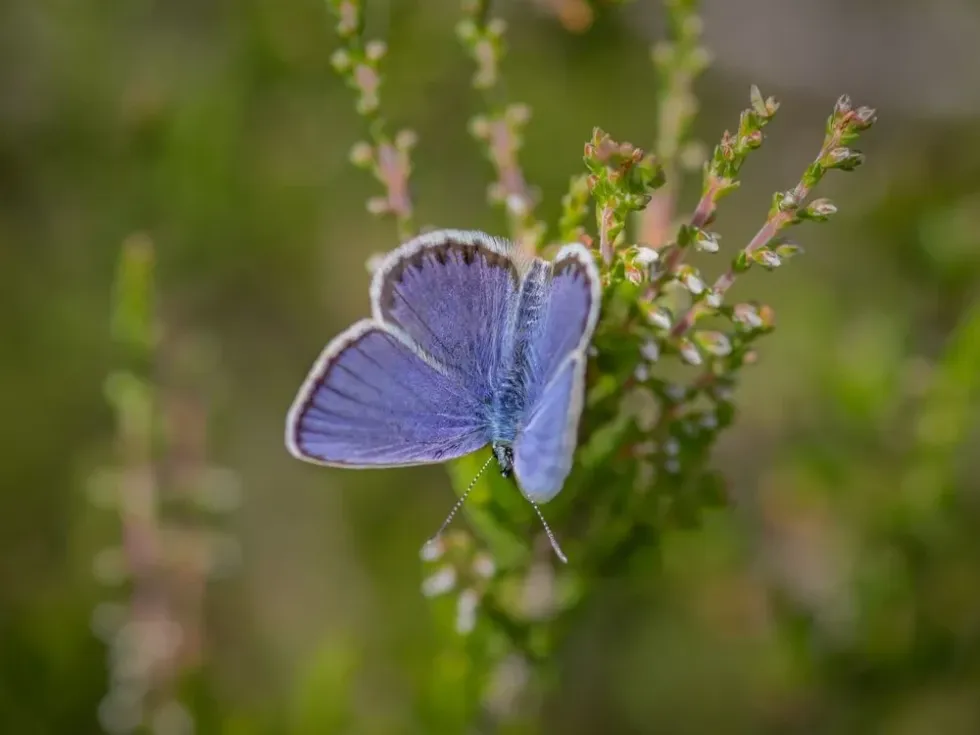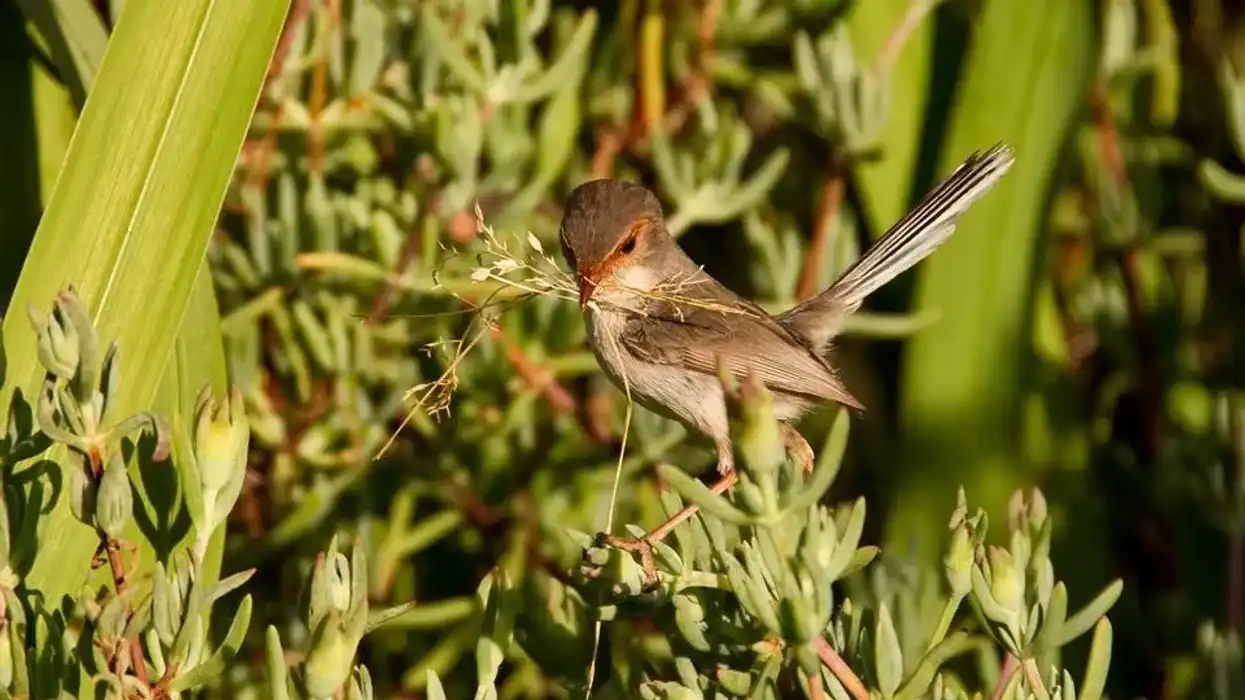The lotis blue butterfly is tiny, having a wingspan of about 0.6-1.3 in (1.5-3.3 cm) at maximum.
It is a tiny, cute, and brightly colored butterfly. The upper wings are in deep violet-blue for males, with a black border and white scales along the outer wing margin, whereas the upper wings are brown or bluish-brown, with an orange band near the outer wings, and a black border and white scales along the outer wings margin.
The wings of both the sexes are grayish-white with withered black, orange spots towards the outer wing margins.
What drove the species toward extinction is still a mystery. The lotis blue was last seen at Pygmy Forest south of Fort Bragg in 1983, on its suspected host plant, seaside bird’s-foot trefoil (Lotus formosissimus).
To know more about butterfly facts explore red admiral butterfly facts and painted lady butterfly facts.
Lotis Blue Butterfly Interesting Facts
What type of animal is a lotis blue butterfly?
The lotis blue butterfly is a very rare tiny beautiful insect that is brightly colored.
It is a Critically Endangered subspecies native to the coast of Mendocino County, California (with sightings in the margins of Sonoma and Marin counties.) According to Lintner, their population density has been listed as an endangered species since June 1, 1976, but has not been sighted in the wild since 1994.
What class of animal does a lotis blue butterfly belong to?
Lotis blue butterfly belongs to the Insecta class of animals. Therefore, they are called with the scientific name Lycaeides argyrognomon lotis.
How many lotis blue butterflies are there in the world?
They have not been seen anywhere in the world since the 1980s. The lotis blue butterfly is by itself a naturally rare insect with a very low population density. Probably their population range may not be known, possibly due to the development in the lands and fields where they were found.
Where does a lotis blue butterfly live?
Lycaeides idas lotis are found in wet meadows and sphagnum willow bogs. The soil is waterlogged and highly acidic. Lotis blue butterfly habitat includes thick shrubs such as California rose, salal, western Labrador tea, wax myrtle, and California huckleberry.
What is a lotis blue butterfly's habitat?
The lotis blue butterfly is related to one of 12 subspecies of L. argyrognomon in North America. It usually inhabits grassy, flowery areas and mixed evergreen forests.
Who do lotis blue butterflies live with?
As these butterflies could not be found for nearly 30-40 years, most studies about this insect are incomplete. However, according to some records, these butterflies lived in packs with other butterflies along the northern coast of Mendocino.
How long does a lotis blue butterfly live?
The lotis blue butterfly has a single generation in a year. Eggs are laid in the relatively long adult flight period, from April to July.
Hatched larvae begin to feed as soon as they are born. However, the lotis blue butterfly life cycle is in three parts. The first is its egg stage, next comes the caterpillar stage, which is also known as the larva stage, and the last is the hatch of the butterfly.
How do they reproduce?
Eggs are laid during the adult flight season. Their breeding time is from mid-April to early June. The Newly hatched larvae begin to feed as soon as they are born, then in winter when they are in diapause state as a small larva.
They resume feeding only in the following spring. The larvae or the caterpillars feed for about four to six weeks in the spring before pupating.
Lotis blue larvae have not been observed. Therefore we cannot find out what type of host plant the larva needs for feeding itself. There is a report recorded that the lotis blue butterfly had an egg-laying behavior on the host plant coast trefoil (lotus formosissimus)
What is their conservation status?
IUCN Red List status of lotis blue is Not Evaluated. However, lotis blue butterfly is federally listed under the Endangered Species Act with status as Endangered; date listed June 1, 1976. In addition, some common predators like secretary birds, king cobra snakes, or even horned toads can threaten these species.
Lotis Blue Butterfly Fun Facts
What do lotis blue butterflies look like?

* Please note that this is an image of a blue butterfly, one of the subspecies of the Lycaenidae family. If you have an image of a lotis blue butterfly please let us know at hello@kidadl.com.
Just like a purple emperor butterfly, these butterflies are also the tiniest thing. The male lotis is brightly colored, while the female lotis is darker and less colorful. The undersides of both sexes are grayish-white, with black and orange spots flecked all over them.
A female lotis blue butterfly is brown, and it has a yellow rim surrounding its body. Each butterfly is about a maximum of 2 in (5 cm) long. If given close attention, you will note that both sides of the wings are symmetrical.
How cute are they?
Butterflies themselves are beautiful flying creatures. Lotis blue butterflies are attractive and cute insects.
How do they communicate?
Lotis blue butterflies communicate through their bright and beautiful, attractive colors, chemicals, sounds, and physical actions, just like any other butterflies. So it is with their colors that the males attract the opposite sex.
How big is a lotis blue butterfly?
It is a small-sized butterfly with a wingspan of 0.6-1.3 in (1.5-3.3 cm).
How fast can a lotis blue butterfly fly?
They can fly as fast as to reach 37 mph (59.5 kph).
How much does a lotis blue butterfly weigh?
They usually weigh around 0.03-0.045 lb (13.6 -20.4 g).
What are the male and female names of the species?
There are no sex-specific names for the males and the females in their species.
What would you call a baby lotis blue butterfly?
The baby of a lotis blue butterfly is called a caterpillar.
What do they eat?
Lotis blue butterflies are herbivores. They are found feeding on plants. They suck nectars from all the flowers, especially the nectar from the lupine plant. Just like other butterflies, these lotis blue also eats during the day. It eats different types of plants that are native to willow bogs and meadows of the coast.
Are they poisonous?
No. These lotis blue butterflies are not dangerous or poisonous to any other species or related subspecies.
Would they make a good pet?
Lotis blues are very beautiful and very wonderful to watch them flying in the field. They are a good source of entertainment for adults as well as kids of all ages.
Apart from entertaining the public, they also help pollinate plants, resulting in varieties of bog and meadows. Having said this, they wouldn't make a good pet because they are wild animals and would likely just fly away.
Did you know...
The lotis blue butterfly is the rarest butterfly in North America. All butterflies, when they migrate, settle in trees. Deforestation and drought mess up their migration patterns. Cutting the trees down will also kill the eggs that are on them. Probably, the ecosystems heat up, and this sudden rise would possibly mess up the migration routes.
The description of a lotis blue butterfly in 1879 by entomologist Lintner, based on a specimen named Mendocino, who wielded the net, remains a mystery. These records have even made the amateur lepidopterist Vladimir Nabokov tired when he revised the taxonomy of North American blues in the 1940s. The lotis blue frequently visited Mendocino and Sonoma county or bog.
The present scenario or the description for a suitable habitat for the species is restricted to a single county or bog in the land of Mendocino’s Pygmy Forest. The blue lotis butterfly, last seen there in 1983.
Entomologist Richard Arnold has made a detailed study in the sun-dappled forest range and reported that the location might be a host for long-lost butterflies.
How did the lotis blue butterfly get its name?
The lotis blue butterfly got its name from the violet-colored males. Lotis blue butterfly's spiritual meaning is complex. It is a sign of life and love.
Why is the lotis blue butterfly endangered?
This butterfly is naturally rare and may become extinct due to natural factors like drying climatic conditions. The changes in the immediate location and vegetation community may affect the species and their subspecies.
Suppression of fires and other such changes are suspected of disturbing open habitats like denser vegetation, forest openings, coastal prairies, and meadows.
As the development for housing and building has increased in the near decades, resulting in loss and degradation of many native habitat areas. Just because the butterflies are associated with natural willow bog and wetlands, groundwaters can also affect the habitat for this kind of species.
Here at Kidadl, we have carefully created lots of interesting family-friendly animal facts for everyone to discover! For more relatable content, check out these monarch butterfly facts and viceroy butterfly facts for kids.
You can even occupy yourself at home by coloring in one of our free printable butterfly side coloring pages.
* Please note that the main image is of a blue butterfly, one of the subspecies of the Lycaenidae family. If you have an image of a lotis blue butterfly please let us know at hello@kidadl.com.










